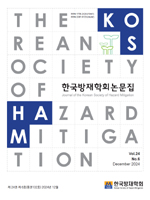내화보드가 부착된 Glulam 기둥의 내화성능
Role of a Fireboards in Enhancing the Fire Performance of Glued-Laminated Timber Columns
- 한국방재학회
- 2. 한국방재학회 논문집
- 24권 6호
-
2024.12183 - 191 (9 pages)
-
DOI : 10.9798/KOSHAM.2024.24.6.183
- 27

최근 건물 부분의 탄소배출량 감소를 위한 노력의 일환으로 중고층 목구조 건축물에 대한 관심이 고조되고 있다. 목재는 탄소를 흡수하고 저장하기 떄문에 친환경적인 소재이지만, 불에 타는 가연성 물질이기 떄문에 화재로부터의 구조안전성확보는 중고층 목조건축물 생태계 구축에 필요한 요소 기술이다. 이 연구에서는 국산목재를 활용한 Glulam 기둥의 내화성능을 규명하기 위해 3시간 내화실험을 수행하였다. 실험에서 고려한 주요파라미터는 목재수종(소나무, 삼나무, 낙엽송), 내화보드 종류(방화석고보드, MgO보드, CRC 보드)와 부착유무이다.
High-rise timber buildings have emerged as a sustainable solution to reduce carbon emissions in the construction sector, offering advantages over multistory steel and concrete structures. However, concerns regarding the structural performance of these buildings during fire remain. Thus, to enhance fire resistance, timber elements are encapsulated in noncombustible materials. This study examines (i) the charring behavior of glued-laminated timber (GLT) columns made from three commonly used wood species in Korea (red pine, cedar, and larch) and (ii) the effect of fireboard types (gypsum, MgO, and CRC boards) on fire performance. Fire tests were conducted on unloaded GLT columns under ISO 834 standard fire conditions. The results include the temperature profiles and charring rates for both protected and unprotected columns, revealing that higher-density GLT columns exhibit reduced charring rates and greater fire resistance. Overall, encapsulation significantly delayed the onset of charring, highlighting its effectiveness in enhancing fire performance.
1. 서 론
2. 국내외 목조부재 내화구조 현황
3. 내화성능 실험계획
4. 내화성능 실험결과
5. 결 론
감사의 글
References
(0)
(0)